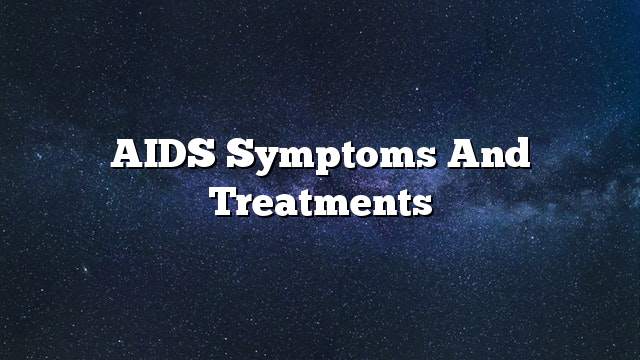AIDS
AIDS is a chronic and serious life-threatening disease. It is caused by an HIV infection. It leads to deficiencies and failures in the human immune system. HIV leads to the body’s inability to fight viruses, bacteria, fungi and bacteria. , And the human body is vulnerable to many diseases, such as: cancers, and a lot of infections such as pneumonia and meningitis. The use of the term AIDS or acquired immunodeficiency syndrome (HIV / AIDS) is an advanced stage of infection. Experts estimate the number of people infected with the virus at 39.5 million worldwide, and despite massive efforts to limit its spread in some countries, the number of infected people is increasing in other countries. The solution to the AIDS problem is to follow awareness, prevention, treatment and coordination.
What are the symptoms of AIDS
Human immunodeficiency virus (HIV) infection comes in three stages:
- Early stages of infection : In early stages of HIV infection, the symptoms are similar to the symptoms of influenza. They disappear within two to four weeks from the moment of HIV infection, also called the acute phase, where the body’s resistance to infection starts and after it is completed the patient enters the next phase of almost no symptoms . The symptoms experienced by the AIDS patient in the acute phase are as follows:
- Fever and fever.
- Feeling of headaches, sore throat, or sore throat.
- Skin rash without the sensation of itching.
- Feeling nauseous with the possibility of vomiting or diarrhea.
- Feeling very tired or tired, and muscle pain also.
- Advanced stages of infection : After the end of the acute phase, the immune system has lost its battle with the virus, and the infection has moved to the second stage, which usually comes without symptoms. At this stage, the patient does not realize that he or she is infected, and is not aware of the possibility of infecting other people, and may last for ten years or more. During this period, HIV slowly kills CD4 cells, a type of T lymphocyte, and the cell targeted primarily by the virus, thereby destroying the immune system. The number of these cells is usually measured, showing a severe decrease, which greatly weakens the body’s immunity and makes it more susceptible to opportunistic infections and cancers, and makes it susceptible to AIDS, the last stage of infection. Although the patient usually does not show any symptoms, but some may suffer from some of the symptoms of the last phase, including:
- Inflammation of lymph nodes.
- Diarrhea.
- Thinness and loss of weight.
- High temperature of the infected body.
- Coughing.
- Shortness of breath.
- The final stages of infection : HIV / AIDS is a short term for AIDS, so the number of CD4 cells is very low. A person with HIV may be diagnosed with AIDS if he or she already suffers from a disease called AIDS-specific diseases such as Kaposi (a type of skin cancer) or pneumonia known as pulmonary embolism. Symptoms of the patient at this stage:
- Feeling tired and tired all the time.
- Swelling of lymph nodes located in the neck or thigh.
- High temperature for more than ten days.
- Severe sweating at night.
- Uncertain weight loss; this is meant to happen without any known cause.
- The appearance of purple spots on the skin and not disappear.
- hard breathing.
- Suffering from severe long-term diarrhea.
- Infection is innate in the mouth, throat or vagina.
- Exposure to bruising easily, and also easy to get bleeding.
People who are most vulnerable to AIDS
HIV is transmitted in many ways, so preventive measures must be taken to prevent transmission, but there are behaviors that increase the chances of its practitioners becoming infected with AIDS and make them more vulnerable to their deadly risks. These behaviors include:
- Unprotected sex with known prevention means, whether it is through the vagina or the anus.
- Other sexually transmitted infections such as syphilis, herpes, chlamydia, streptococcus, or bacterial infections in the vagina.
- Participation of injecting drug addicts or needles or contaminated solutions.
- Exposure to a medical procedure such as injections, blood transfusions, or any other procedure requiring puncture or penetration of the skin in unhealthy conditions that lack sterilization and safety conditions.
- Exposure to unintentional tingling, especially among health workers.
AIDS treatment
HIV is treated by combining a range of drugs called antiretroviral therapy. These drugs are not a definitive cure, but they control the virus and thus improve the patient’s life, increase his chances of survival, and reduce the likelihood of transmission to others. These drugs also prevent the virus from reincarnation, thus reducing the amount of blood in the patient by giving the immune system an opportunity to recover and fight infections and opportunistic cancers. These drugs are given to all patients with HIV regardless of how long they have been infected. If left untreated, the immune system will be affected further and the infection develops into the AIDS phase.
